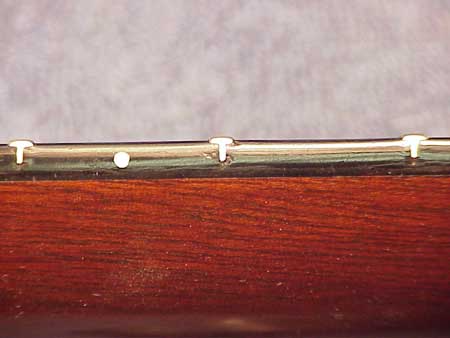End Chips
© Frank Ford, 3/12/00; Photos by FF
Most luthiers agree that a fret should be bent to a slightly higher arc than that of the fingerboard. That way, the fret ends are more likely to be "sprung" downward, reducing the chances that they will become loose.
But, as the fret is tapped in place, the ends spread out a bit. As the ends poke sideways out the ends of the fret slots, the little tang barbs can lift flakes of wood or finish. Most of the time, such flakes are easily reglued or filled during the process of filling the ends of the fret slots after the frets are trimmed.
End chips are hardly ever visible on a bound fingerboard, unless the fret also pushes the binding off the edge.
Here's a view of that problem:

This particular fret job was done with a bit less attention to detail than most of us would like to see. The fret ends weren't filled effectively, and the chips were left unfilled:

What to do about such a problem. Fill the chips. Not a very complicated process, and usually a bit of cyanoacrylate will do nicely. As the frets are trimmed and polished, the edges of the fingerboard will also be leveled, along with any small amounts of fill material.
Back to Fret Trouble Page
Back to Index Page